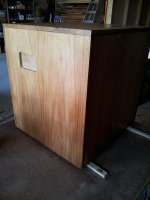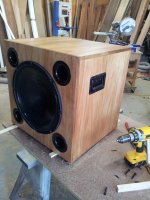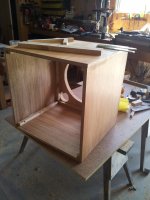+ what epa said, a little roll-off isn't a bad thing. Depending on the size of the room you will use this in and how many openings it has to other rooms, it may end up about flat. (true flat to 25Hz = wife yelling about things falling off walls, shelfs, end tables) Also the lower the tuning the better the group delay in the audible range = better integration/clarity with the upper harmonics of bass guitar, drums, bassoon etc...
Alright thanks for that guys!
Amp wise I am now looking at the XTi series 2 range.
Any thoughts on these?
Crown XTI1002 power amplifier 500W/ 4ohms - JDs Sound and Lighting
Would be giving 1000w bridged @ 8 ohm.
From the reviews I have read the original XTi's were pretty dismal, but from the new series 2 they sound pretty impressive!
Any other big brand amps I should take a look at? (For ease of purchasing)...
Thanks!
Felix.
Amp wise I am now looking at the XTi series 2 range.
Any thoughts on these?
Crown XTI1002 power amplifier 500W/ 4ohms - JDs Sound and Lighting
Would be giving 1000w bridged @ 8 ohm.
From the reviews I have read the original XTi's were pretty dismal, but from the new series 2 they sound pretty impressive!
Any other big brand amps I should take a look at? (For ease of purchasing)...
Thanks!
Felix.
Felix, 170Litre cab minus the basreflex port, driver's volume and bracing (you will need a lot) will end around a 150Litre cab. Tune it between 30Hz and 34Hz (depending how many drivers you are going to use) and you will be okay.
The stated specs speak of an Xmax of 12.9mm each way. The Xvar of this driver is above 15mm easy so it will display quiet a lot of air at full power. There is a marge between the drivers in real life and factory specs that end up most time in favour of the real life drivers (I wish other drivers had the same thing). A 1000W amplifier will be completely bottomed out so make sure the signal stays clean otherwise it will burn the VC of your driver!!!
Remember distortion at low frequency is a lot more difficult to detect by your ears then distortion in the higher regions of the sub range. These drivers are most time killed by too light amplifiers instead of too much power. Therefore a heavier amp wouldn't be a luxury for these drivers for PA tasks. Also make sure you use a decent low cut filter (especially when used for PA) or you will drive the excursion to and over its mechanical limits since the motor of these drivers are more than capable.
The stated specs speak of an Xmax of 12.9mm each way. The Xvar of this driver is above 15mm easy so it will display quiet a lot of air at full power. There is a marge between the drivers in real life and factory specs that end up most time in favour of the real life drivers (I wish other drivers had the same thing). A 1000W amplifier will be completely bottomed out so make sure the signal stays clean otherwise it will burn the VC of your driver!!!
Remember distortion at low frequency is a lot more difficult to detect by your ears then distortion in the higher regions of the sub range. These drivers are most time killed by too light amplifiers instead of too much power. Therefore a heavier amp wouldn't be a luxury for these drivers for PA tasks. Also make sure you use a decent low cut filter (especially when used for PA) or you will drive the excursion to and over its mechanical limits since the motor of these drivers are more than capable.
Thanks Djim sounds good!
When you say to use a low cut filter do you mean to cut out extremely low frequencies? IE ~10-15Hz? Due to the excursion being too great down really low? If so how do you best do this?
Also when it comes to box bracing, what’s the golden rule? I've seen a few designs over the internet, but none of them really explain the sound impact the brace design has... I could imagine that if braced incorrectly it could really affect the air movement within the box! Generally is just cross bracing through the centre of the box sufficient? I have also seen some with full shelves across the centre of the box with say 4 holes cut out?
I plan on using 3/4" MDF, double front baffle. However may go to 1" if there is a need.
Also lastly, I have read it's a good idea to keep the dimensions (H,W,D) not equal to each other to reduce panel resonances. Is this correct?
Thanks!
When you say to use a low cut filter do you mean to cut out extremely low frequencies? IE ~10-15Hz? Due to the excursion being too great down really low? If so how do you best do this?
Also when it comes to box bracing, what’s the golden rule? I've seen a few designs over the internet, but none of them really explain the sound impact the brace design has... I could imagine that if braced incorrectly it could really affect the air movement within the box! Generally is just cross bracing through the centre of the box sufficient? I have also seen some with full shelves across the centre of the box with say 4 holes cut out?
I plan on using 3/4" MDF, double front baffle. However may go to 1" if there is a need.
Also lastly, I have read it's a good idea to keep the dimensions (H,W,D) not equal to each other to reduce panel resonances. Is this correct?
Thanks!
Last edited:
I'm sure Djim was talking about a high-pass filter sometimes called a rumble filter to stop very low frequencys from over exerting.. over excersioning  .. the driver.
.. the driver.
this is something i wrote on the http://www.diyaudio.com/forums/cons...ion-what-materials-build-speakers-out-82.html thread.
"huh... a brace is not really used as a panel stiffener, it does that but that is not why it works, it bisects the surface in the same way your finger does when you press down on a guitar fret board, put your finger half way down the string and you rase the pitch one octave. If the open panel primary resonance is say 500Hz and you bisect it once with a vertical brace you get two panels with primary resonance of 1kHz bisect those vertically and you get four panels with primary resonances of 2kHz.
technically two vertical braces on 3rd's will rase the panel resonance more than an X brace, as an X brace only moves the resonance one octave and the two vertical braces on 3rd's rase the panel resonance one octave + perfect 5th.
raising the resonances as much as possible then damping (impedience mismatch) the open areas with something heavy and flexible like pond liner glued down with silicone has worked well for me." (can I quote myself?...)
about dimensions: with a subwoofer it dosen't really matter if it's a perfect cube or you use the golden dimensions as long as it's well damped with braces etc. I always just make the box to fit the space (as they tend to be large boxes anyway) then use braces to make the open panel spaces varient.
this is something i wrote on the http://www.diyaudio.com/forums/cons...ion-what-materials-build-speakers-out-82.html thread.
"huh... a brace is not really used as a panel stiffener, it does that but that is not why it works, it bisects the surface in the same way your finger does when you press down on a guitar fret board, put your finger half way down the string and you rase the pitch one octave. If the open panel primary resonance is say 500Hz and you bisect it once with a vertical brace you get two panels with primary resonance of 1kHz bisect those vertically and you get four panels with primary resonances of 2kHz.
technically two vertical braces on 3rd's will rase the panel resonance more than an X brace, as an X brace only moves the resonance one octave and the two vertical braces on 3rd's rase the panel resonance one octave + perfect 5th.
raising the resonances as much as possible then damping (impedience mismatch) the open areas with something heavy and flexible like pond liner glued down with silicone has worked well for me." (can I quote myself?...)
about dimensions: with a subwoofer it dosen't really matter if it's a perfect cube or you use the golden dimensions as long as it's well damped with braces etc. I always just make the box to fit the space (as they tend to be large boxes anyway) then use braces to make the open panel spaces varient.
Last edited:
No, not an ‘extremely’ one. But if you model a basreflex watch how the excursion raises below the Fb of the system. The low cut filter is to prevent extreme excursion. Especially so called extended LF drivers with a very strong motors and heavy cones will tend to loose control over excursion at frequencies below Fb (system resonance).When you say to use a low cut filter do you mean to cut out extremely low frequencies?
For instance a 170Litre cab tuned to 30Hz with this driver will need a 24dB/oct Linkwitz-Riley filter set at 21Hz or a 12dB/oct Butterworth set at 30Hz. You can see the excursion in WinISD and find the right setting for each type of filter (“EQ/Filter” menu). To do so you need to fill in the max power (“signal” menu). Always remember simulating software doesn’t take losses in account such as power compression or tolerances in the drivers data!IE ~10-15Hz? Due to the excursion being too great down really low? If so how do you best do this?
There are no rules as long the airflow isn’t obstructed too much. People tend too make the internal bracing symmetric (centre) which looks better but in fact halves the walls (or triples) in perfect sections of the same length. That means the resonances just shift two times up. I prefer to use non symmetric distances to make sure wall resonances are broken up in several different frequencies.Also when it comes to box bracing, what’s the golden rule? I've seen a few designs over the internet, but none of them really explain the sound impact the brace design has... I could imagine that if braced incorrectly it could really affect the air movement within the box! Generally is just cross bracing through the centre of the box sufficient?
The effects of going beyond 22mm of standard high density MDF is very low. However, since you are also using these cabs as PA subs you could consider lower mass materials like Baltic (Birch) multiplex to keep the total weight within practical limits. We only build full MDF cabs in case of VAST installations. For PA we use premium quality 18mm Scandinavian multiplex to keep weight as low as possible.I plan on using 3/4" MDF, double front baffle. However may go to 1" if there is a need.
You can read a lot things but dimensions are most time set out by standards as used by manufacturers or simple because of practical reasons and both methods will work. The internal resonances you are talking about can be taken care off by correct bracing.Also lastly, I have read it's a good idea to keep the dimensions (H,W,D) not equal to each other to reduce panel resonances. Is this correct?
Last edited:
I only remembered the other day I should post up a final review now that I have this thing built so thanks Bart for kicking me along!.
Built it over the summer out of 3/4 MDF with a Tas Oak veneer.
135L box tuned to ~32.5Hz, 80mm ports and bracing galore!
Powered it with a Crown XTI2 1000w into 8 ohms.
As for the sound I can't give you any measured readings (SPL etc) as I don't own any of the gear however I am so impressed with how low/loud it goes.
It's pretty ridiculous really, gives you a full body massage if you sit too close.
I mainly listen to heavy bass music where this does not hold back one bit, handling any of the low frequency's without any problem.
This sub also makes watching movies 10x better, everyone smiles whenever there is an explosion etc ha.
I don't know how I can add much more really...
I guess only that in my (very limited) opinion this isn't the best sub on paper and has been around for a few years however that shouldn't rule it out if the application arises.
One of the reasons I purchased this was because it was easily available and other options would have required importing (not keen).
How it compares to other subs in this price range I cannot comment as this is the first I have built/experienced, however bottom line is it holds itself superbly down at those looooww frequencies and provides some "far too high for everyday listening SPL's". This thing makes powering up my sound gear every day an absolute joy - I definitely haven't been disappointed!
The only downside to building this is I am now starting to think about my next project.... probably some bigger mid/treble cabs to match!
I might get around to taking some proper photo's of it installed.... we'll see!
Cheers,
Felix
Built it over the summer out of 3/4 MDF with a Tas Oak veneer.
135L box tuned to ~32.5Hz, 80mm ports and bracing galore!
Powered it with a Crown XTI2 1000w into 8 ohms.
As for the sound I can't give you any measured readings (SPL etc) as I don't own any of the gear however I am so impressed with how low/loud it goes.
It's pretty ridiculous really, gives you a full body massage if you sit too close.
I mainly listen to heavy bass music where this does not hold back one bit, handling any of the low frequency's without any problem.
This sub also makes watching movies 10x better, everyone smiles whenever there is an explosion etc ha.
I don't know how I can add much more really...
I guess only that in my (very limited) opinion this isn't the best sub on paper and has been around for a few years however that shouldn't rule it out if the application arises.
One of the reasons I purchased this was because it was easily available and other options would have required importing (not keen).
How it compares to other subs in this price range I cannot comment as this is the first I have built/experienced, however bottom line is it holds itself superbly down at those looooww frequencies and provides some "far too high for everyday listening SPL's". This thing makes powering up my sound gear every day an absolute joy - I definitely haven't been disappointed!
The only downside to building this is I am now starting to think about my next project.... probably some bigger mid/treble cabs to match!
I might get around to taking some proper photo's of it installed.... we'll see!
Cheers,
Felix
Attachments
- Status
- This old topic is closed. If you want to reopen this topic, contact a moderator using the "Report Post" button.
- Home
- Loudspeakers
- Subwoofers
- Monacor SPH-450TC Thoughts?


